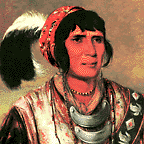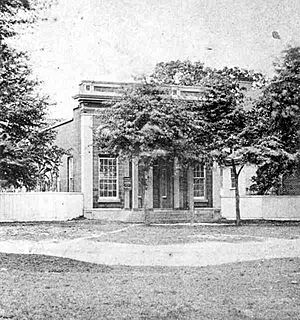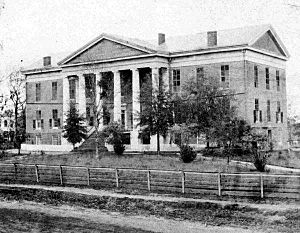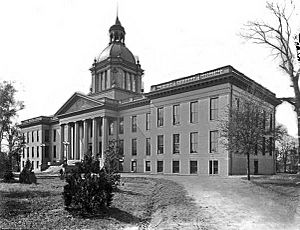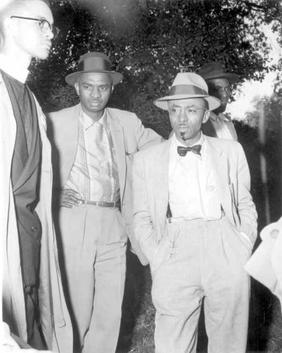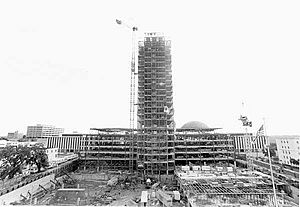History of Tallahassee, Florida facts for kids
The history of Tallahassee, Florida, like the history of Leon County, Florida, goes back a long time. It started with the first people who lived here. In the 1500s, Europeans began to settle the area. It became part of Spanish Florida. In 1819, a treaty gave Spanish Florida, including what is now Tallahassee, to the United States. Tallahassee became a city and Florida's capital in 1821. The American takeover led to fast growth. Many cotton farms started nearby, making Tallahassee's population much bigger.
Early History
Tallahassee is in the area once called the Apalachee Province. This was home to the Apalachee people. They were a Mississippian culture group who farmed large areas of land. Their main town, Anhaica, was located within today's Tallahassee.
The name "Tallahassee" comes from a Muskogean Indian word. It often means "old fields" or "old town." This name might come from the Creek (later called Seminole) Indians. They moved into this region in the 1700s. The Apalachee people were very good farmers. The Spanish noticed this and sent missionaries to the area in the 1600s. Several missions were built to get food and workers for the colony at St. Augustine. One important mission, Mission San Luis de Apalachee, has been partly rebuilt as a historic site in Tallahassee.
16th Century
The Spanish missionaries were not the first Europeans to visit Tallahassee. The Spanish explorer, Hernando de Soto, stayed the winter of 1538-1539 at the Apalachee village of Anhaica. He had taken the village by force. De Soto treated the native people very harshly. They fought back strongly. By the next spring, De Soto was ready to leave. Florida archaeologist B. Calvin Jones found the site of Anhaica, near today's Myers Park, in 1987.
19th Century
Locating a Capital
The founding of Tallahassee was mostly about making things easier. In 1821, Spain gave Florida to the United States. A government was set up for the territory. But it was hard to meet alternately in St. Augustine and Pensacola. These were the two biggest cities then. So, the governor, William Pope Duval, chose two people to find a more central meeting place.
In October 1823, John Lee Williams and Dr. William Simmons picked the old Indian settlement of Tallahassee. It was roughly halfway between the two cities. They also chose it because it was high up and near a beautiful waterfall. This waterfall is now part of Cascades Park. It was also near the old capital of the Apalachee chiefs. In March of the next year, it was officially named the capital. Florida did not become a state until 1845.
On November 1, 1823, John Lee Williams wrote about the capital's location:
"Doct. Simmons has agreed that the Site should be fixed near the old fields abandoned by the Indians after Jackson's invasion, but has not yet determined whether between the ... old fields, or on a fine high lawn about a mile W. In both spots the water is plenty and good."
Founding of Tallahassee
In 1824, the city of Tallahassee was established. It became the main city in Leon County. This happened after the state government decided to put the capital of the new Florida Territory in the middle of St. Augustine and Pensacola. The city was officially made a town in December 1825. The first city elections were held in January 1826.
In 1824, Marquis de Lafayette received a land grant from the United States Congress. This grant was a 6-mile by 6-mile square of land. Today, most of it is in northeast Tallahassee. The Marquis never visited his land in Florida. But he sent people to grow limes and olives and to make silk. However, the colony failed. Most residents went to New Orleans or back to France. Those who stayed lived in an area of Tallahassee still called Frenchtown. Lafayette eventually sold his property.
In 1826, Prince Achille Murat, who was Napoleon Bonaparte's nephew, moved to the Tallahassee area. He likely came because of the Lafayette Land Grant, which also drew other French settlers. He bought land in Jefferson County, Florida. He named it Lipona Plantation. "Lipona" is "Napoli" (Naples, Italy) spelled backward. He was supposed to rule Naples.
In 1827, Ralph Waldo Emerson visited Tallahassee. He called it "A grotesque place of land speculators and desperados." Emerson later became a good friend of Achille Murat.
1830s
First Bank
Around 1830, the Union Bank was started by William Williams. It was Tallahassee's first bank. The Seminole Wars, bad banking choices, and the Panic of 1837 caused the bank to close in 1843. In 1847, cotton farm owners William Bailey and Issac Mitchell bought the bank. After the American Civil War, it became a bank for Black people until 1879. The building has been used for many things. These include a church, a feed store, an art house, and a shoe factory. In 1971, the bank building was moved from its first spot to near the Capitol.
Capitol Building
The rough frontier capital slowly grew into a town during Florida's time as a territory. Before becoming a state, the territorial government built a grand greek revival building. This was meant to be a state capitol. The building opened in 1845, just in time for statehood. It is now known as the "old Capitol." It stands in front of the current tall capitol building today.
Tallahassee-St. Marks Railroad
In 1834, the Tallahassee Railroad was built. It connected St. Marks with Tallahassee. This helped ship cotton to ports in the northeast. It is said to be the third oldest railroad in the United States. Three years later, it was extended to Port Leon. Port Leon was briefly the main town of Wakulla County until a hurricane destroyed it. In 1856, the mule-drawn line with wooden rails was replaced. It got steel rails and steam trains. Today, the route is paved and is the Tallahassee-St. Marks Historic Railroad State Trail.
Also in 1834, Thomas Brown built an inn called Brown's Inn. He later became Florida's governor.
1840s
Reform Mayor
In 1841, Francis W. Eppes became the mayor of Tallahassee. He was the grandson of Thomas Jefferson and a successful cotton farm owner. Eppes was mayor until 1844. He said the town's Marion Race Course was "A hotbed of vice, intemperance, gambling and profanity." He felt the rest of the town was not much better. Eppes served as mayor again from 1856 to 1857.
1850s
During the time before the American Civil War, Tallahassee was key to Florida's fast-growing "middle counties." These counties had most of the state's population back then. For decades before the Civil War, nearby Gadsden County was the most populated in the state. Cotton and tobacco farms, along with smaller farms, were the main reasons for population growth. They also brought economic and political power. Many cotton farms, like the William Bailey Plantation and Francis Eppes Plantation, were built within what is now Tallahassee.
1860s
Civil War
Tallahassee was the only capital city of the Confederate states east of the Mississippi River that was not captured by Union forces during the American Civil War. It was also the only one not burned. The Battle of Natural Bridge was fought outside Tallahassee. Students from what would later become Florida State University mostly fought in this battle. This makes it the only non-military school to have such a claim.
Reconstruction
After the Civil War, much of Florida's industry moved south and east. This trend continues today. The end of slavery hurt the cotton and tobacco businesses. The state's main industries changed to citrus, naval stores, cattle ranching, and even tourism. These grew more in the south and east because of the climate and land. This growth was especially clear around the Jacksonville area and the St. Johns River.
At the same time, newly freed Black people created Frenchtown. This is the oldest historically Black neighborhood in Florida.
1880s
First Universities
In January 1883, Reverend John Kost suggested creating a state university. This was required by the 1868 Constitution. Kost chose Tallahassee and the West Florida Seminary for the university's location. Classes were held at the West Florida Seminary from 1857 to 1863. Then, the state government changed its name to The Florida Military and Collegiate Institute. This was to show that a military section had been added to train cadets. The university was called the Florida State College for Women and later became Florida State University.
On October 3, 1887, the State Normal College for Colored Students began classes. It became a land grant university four years later. It received money under the Second Morrill Act. Its name changed to State Normal and Industrial College for Colored Students. However, it was not an official higher education school until the 1905 Buckman Act. This act created the foundation for the modern Florida A&M University.
Capital City Bank
George W. Saxon, who owned a dry goods store, started lending money to farmers in the 1880s. This led him to apply for a bank license in 1895. The bank grew. By 1975, Saxon's great-grandson, DuBose Ausley, started forming several banks into one group. Capital City Bank now has many banking offices. It serves people from Alabama and Georgia down to Port Richey, Florida.
Carrabelle, Tallahassee and Georgia Railroad
During the 1880s and 1890s, Tallahassee was served by the Carrabelle, Tallahassee and Georgia Railroad. This railroad ran from Georgia to Tallahassee and then to Carabelle in Franklin County.
St. James and Leon Hotels
The St. James Hotel was built between 1870 and 1883. It was a 3-story hotel with a porch on two sides. It was located at the corner of Monroe Street and Jefferson Street. The St. James became the Bloxham House from 1909 to 1913. This building was moved to 410 N. Calhoun Street. It is important locally and statewide. It served as the home for Governors William D. Bloxham and Madison S. Perry from 1881 to 1901. It is also Tallahassee's best example of Federal residential architecture. In 1980, the Florida Heritage Foundation helped restore this building.
In 1881, the Leon Hotel was built at 110 East Park Avenue. It was a Victorian style 2-story building. It had fancy porches on both the first and second floors and large grounds. A fire destroyed the Leon Hotel in 1925.
Gallery
20th Century
For much of the 1900s, Tallahassee stayed a quiet government and college town. Politicians would meet there to talk about spending money on big public projects. These projects were to help growth in places like Miami and Tampa, far from the capital. By 1901, new roads and railways kept pushing growth south. First, the Plant System Railroads went to the new port of Tampa. Then, the Flagler railroad went to the distant outpost of Miami. However, Tallahassee was firmly set as the capital. In that year, the 1845 capitol building was made bigger with two new wings and a small dome.
1900 to 1930
In 1905, Florida State College became a women's school called the Florida Female College. In 1909, its name changed to Florida State College for Women.
In 1919, the Florida Legislature passed a new city plan for Tallahassee. It allowed for a Commission-Manager form of government. The position of directly elected mayor ended. A system began where city commissioners took turns being mayor.
The Floridan Hotel opened on May 2, 1927. It was at the corner of Monroe Street and Call Street. It became the home for state lawmakers during legislative sessions. People said that more of Florida's business happened in the Floridan than in the Florida Capitol. The Tallahassee Rotary Club met there during this time. The Floridan was torn down in 1985. The 4-story Cherokee Hotel was built in 1922 at Park Avenue and Calhoun Street.
In 1928, the City of Tallahassee bought a 200-acre piece of land for $7,028. This was for its first city airport. It was named Dale Mabry Field after Tallahassee native Army Captain Dale Mabry. The airport opened on November 11, 1929. Ivan Munroe was its first manager.
1930 to 1950
In 1931, the Lively Vocational Technical School was started. It is still open today.
In 1947, the state government allowed Florida State College for Women to accept both male and female students again. This led to the founding of Florida State University.
Musician and entertainer Ray Charles made Tallahassee his part-time home. Charles started playing with the Florida A&M University student band. He also played with jazz brothers Nat Adderley and Cannonball Adderley.
1950s
Tallahassee Bus Boycott
On May 26, 1956, two Florida A&M University students were arrested. Tallahassee Police arrested them because they refused to give up their seats next to a white passenger. They were accused of "inciting a riot." However, the white woman they sat next to did not object. The next night, a cross was burned outside their rooming house. Carrie Patterson was a 21-year-old FAMU junior, wife, and mother. Wilhemina Jakes was a 26-year-old FAMU senior. Both young women were studying elementary education at FAMU.
Reverend C. K. Steele and Robert Saunders from the NAACP started talks. At the same time, Black people began boycotting the city's buses. This boycott was like the Montgomery Bus Boycott with Rosa Parks. Former bus riders started a car pool that lasted until May 26, 1957. Several other events happened that would change segregation in Tallahassee. The Inter-Civic Council ended the boycott on December 3, 1956.
On January 7, 1957, the City Commission removed the bus-franchise segregation rule. This was because a recent federal ruling outlawed segregated buses in Florida. Tallahassee's bus station would later be named after Steele.
1960s
Civil Rights Protests
On March 16, 1960, the Tallahassee Police Department used tear gas to break up a student protest. Protesters also tried to boycott "the Mecca," a popular restaurant near Florida State University. Similar protests happened against McCrory's, Woolworth's, Walgreens, and Sears.
The New Capitol Building
By the 1960s, some people wanted to move the capital to Orlando. This was because Orlando was closer to the state's growing population centers. However, that idea was defeated. The 1970s saw the state commit to Tallahassee as the capital. They built the new capitol complex and saved the old capitol building.
In 1961, Tallahassee Regional Airport opened.
First Subdivision
In 1964, Killearn Estates became Tallahassee's first planned community. It was built on land owned by the Coble family, known as Velda Farms. It was special because it had underground utilities, which kept a natural look.
Tallahassee Community College
In 1966, Tallahassee Community College was established. It was located just east of what was Dale Mabry Field. TCC grew and now teaches over 14,000 students each semester.
Recent History
Tallahassee has grown more in recent years. This is mainly due to government and research services connected to the state and Florida State University. Also, more retired people are finding Tallahassee a good choice. It offers an alternative to South Florida's high housing prices and crowded areas.
1990s
In 1997, Tallahassee citizens chose Scott Maddox as their first directly elected Mayor since 1919.
2000s
The U.S. presidential election of 2000 between Al Gore and George W. Bush largely played out in Tallahassee. Bush won the election night vote count in Florida by a little over 1000 votes. Florida state law required an automatic recount because the difference was so small.
The election was very close. Both the Bush and Gore campaigns got ready for the legal process. The Bush campaign hired James Baker to lead their legal team. The Gore campaign hired Warren Christopher and Tallahassee lawyers W. Dexter Douglass and John Newton.
The Gore campaign asked for disputed ballots in four counties to be counted by hand. Florida law also required all counties to report their results, including any recounts, by 5 p.m. on November 14.
At 4:00 p.m. EST on December 8, the Florida Supreme Court ordered a manual recount. This was for disputed ballots in all Florida counties. The decision was announced live on TV. The Court also said that only "undervotes" (ballots where no clear choice was made) should be counted. The results of this count were to be added to the November 14 tally. This count was happening on December 9. Then, the United States Supreme Court stopped the incomplete recount.
Black History
Slavery Followed by Segregation
Tallahassee has a strong Black history. Before the American Civil War, Leon County led the state in cotton production. It had the most plantations in Florida. Tallahassee was centrally located. It was the center of Florida's slave trade. In 1860, 73% of Leon County's population was Black. Almost all of them were slaves. There were more slaves in Leon County than in any other county in Florida. (Nearby Gadsden County is the only county in Florida with a majority African-American population today.) Also, Tallahassee is home to the state's largest and only public historically Black higher education school, Florida A&M University. It was founded in 1877. The Emancipation Proclamation is celebrated on May 20 each year at the Knott House. The proclamation was read there on May 20, 1865.
Tallahassee is also home to the John G. Riley Center/Museum of African American History & Culture and the Carrie Meek and James N. Eaton, Sr., Southeastern Regional Black Archives Research Center and Museum.
Like other Southern cities, Tallahassee was segregated. This lasted from the end of Reconstruction until the early 1970s. The closing of the underfunded Florida A&M Hospital in 1971 marks the end of segregation in Tallahassee. Tallahassee's strict segregation led to its nickname "Little Mississippi." Racism before integration was described as "virulent." Real estate deeds in white neighborhoods often had rules against selling to Black people. Tallahassee turned down Andrew Carnegie's offer to build a library. This was because Carnegie's rules said it would have to serve Black patrons. (Carnegie then built the Carnegie Library on the campus of what is now Florida A&M University in 1907.) Tallahassee's former whites-only public library is now the David S. Walker Library.
Schools, buses, churches, stores, movie theaters, hospitals, parks, and even cemeteries were also segregated. (Greenwood was the cemetery for Black people.) There was a Colored Hook and Ladder Company (fire department). The city fire department did not respond to the fire that destroyed the Lincoln Academy in 1872. This was because of "insufficient hoses." The local newspaper, the Tallahassee Democrat, had a regular Black section. White subscribers received the business section instead.
Frenchtown
After the American Civil War, many newly freed Black people settled in the area known as Frenchtown. This was because it was part of the Lafayette Land Grant. It was on lower, less desirable land northwest of the Capitol and the Florida Governor's Mansion. The Governor's Mansion is only two blocks from Macomb Street, which was Frenchtown's business center. Today, Frenchtown's southern border is Tennessee Street. But it used to go down to Park Avenue, including land where the LeRoy Collins Leon County Public Library now stands. Frenchtown is the oldest historically Black neighborhood in Florida.
By the 1900s, Frenchtown had its own stores, doctors, pharmacy, schools, restaurants, nightclubs, and a movie theater on Tennessee Street. When James Baldwin visited to read his work at FAMU, he stayed at the Tookes Hotel. Frenchtown was a stop on the Chitlin' Circuit. Famous Black musicians like Louis Armstrong, B.B. King, Ray Charles, Cab Calloway, Little Richard, and Nat and Cannonball Adderley performed there. In the 1940s, Ray Charles and the Adderley brothers lived there. All the businesses and night clubs on the west side of Macomb Street were torn down when the street was widened around 1990. Macomb Street, along with Old Bainbridge Road, was the main route out of Tallahassee to the northwest in the early 1900s.
The community was served by the Lincoln Academy, then Lincoln High School. This was the first school for Black people in Leon County. It was one of only three schools in the state that offered secondary education to African Americans. Its first principal was John G. Riley. He was born a slave and led the local chapter of the National Association for the Advancement of Colored People. Its final building was on Brevard Street, facing Macomb Street. It closed in 1969. This happened when Black students were allowed into the previously all-white Leon High School. Often, during desegregation, Black facilities closed. This also happened with the Florida A&M University College of Law and the Florida A&M Hospital. The building, now called the Lincoln Center, is used for social services. It has no connection to the current, distant Lincoln High School.
A bus line ran south from Frenchtown to Florida A&M University. Along South Adams Street, there was a second, smaller group of Black businesses. This bus route still exists today.
Until Colorado Street was extended around 1990, Frenchtown had no direct connection to the white neighborhoods to its north.
Desegregation
A bus boycott in 1956 was inspired by the one in Montgomery, Alabama. It was the first to follow it. This boycott led to integrated seating in 1957, after cross burnings and violence. This successful boycott helped with the desegregation of the Miami Transit Company in 1957.
The bus boycott shocked white people in Tallahassee. They believed the city had "contented blacks and 'good race relations.'" It marked the start of the Civil Rights Movement and desegregation in Florida.
Fifty years later, the Tallahassee Democrat newspaper apologized for how it covered the boycott. It admitted its coverage had a segregationist viewpoint.
In 1960, Black students and supporters held a series of sit-ins. They were inspired by the famous sit-ins at a Woolworth's lunch counter in Greensboro, North Carolina. These sit-ins happened at the lunch counter of Tallahassee's Woolworth's. At least one white student from FSU was expelled for taking part. The sit-ins were not immediately successful (Woolworth's ended segregation nationally in 1962). They also helped segregationist governor Farris Bryant win election later in 1960.
Because of picketing and sit-ins organized by the local chapter of CORE, by 1963, lunch counters at Sears, Neisner's, Walgreens, McCrory's, and Woolworth's agreed to serve all customers. The two bus stations were desegregated, as was the city courtroom. The airport restaurant also became open to everyone.
On May 30, 1963, 220 pro-integration protesters were arrested. Most were FAMU students. They were protesting in front of Tallahassee's Florida and State Theatres. Later that day, 100 students marched in support of the first group. City, county, and state police met them with tear gas. 37 were arrested. The charges were later dropped. At some protests, there were white counter-protesters. They carried signs saying "Darkies Back to Africa" and "The South Will Rise Again".
Like elsewhere, the hardest part of the fight for integration in Tallahassee was the school system. The Supreme Court ruled in Brown v. Board of Education (1954) that segregated schools were against the law. In 1955, the court said that this decision should be followed "with all deliberate speed." But no schools in Florida were desegregated until 1959. Many Floridians saw Brown v. Board of Education as "a day of catastrophe." Florida counties fought integration "by every means." Lawsuits in federal courts, county by county, were needed for integration to happen. Leon County "fought school integration as strongly as any community in Florida." Florida schools were not fully desegregated until the late 1960s. In Tallahassee, this happened only after strong segregationists left for three new private schools. Governor Leroy Collins (1955-1961) supported gradual school desegregation. He was the first Southern official to do so. But the state government passed a resolution saying Brown v. Board of Education was "null and void." They called it a federal interference with states' rights. By the time Collins left office in 1961, Tallahassee, like most of Florida, wanted to keep a segregated school system.
In 1965, the Florida government stopped funding the FAMU law school. It soon closed. A new one was set up at FSU the next year. This was likely a response to the pressure for integration and FAMU students' activism.
Governor Bob Graham (1979-1987) often spoke about merging Florida A&M University with the formerly all-white Florida State University. FSU admitted its first African-American student in 1962. The idea of merging was discussed in several legislative sessions. Strong voices from the Black community led to this idea being dropped. The Florida Board of Regents tried another way to achieve integration. They decided in 1985 to put a new pharmacy school at FAMU instead of FSU. This also failed as a step toward integration. The school remained mostly white on the otherwise Black campus. The Florida A&M University – Florida State University College of Engineering was founded as a joint project of the two universities. It is located between them.
After Integration
Since 1960, Tallahassee has changed its attitudes greatly. In terms of racism, it has gone from arguably the most racist city in the state to one of the most accepting. Politically, Leon County is now the most liberal (Democratic) county in all of north Florida.
This change is due to many students and workers moving to Tallahassee. They came from other parts of Florida, and from outside the state and the South. This was mainly driven by the start and huge growth of Florida State University. It was founded in 1947, partly to serve World War II veterans. Its earlier form, Florida State College for Women, was politically liberal and supported integration. But it was small and its staff and graduates had little political power. Secondarily, Tallahassee's change is due to Florida A&M University and the changing population of Florida itself. Florida's population growth has come from people moving in from other, usually more liberal, parts of the country. As the state became more liberal, so did the lawmakers and their staff.
As a result, recent racial tensions in Tallahassee have been milder than in many other cities. There were no riots like those in Miami in 1968 and 1980. Also, unlike Miami, Tallahassee's Black neighborhoods were not affected by highway construction. An African American, James R. Ford, was elected mayor in 1972. He was re-elected twice, serving until 1986. He was previously head of the Leon County School System. In 1982, Tallahassee elected Alfred Lawson, Jr. to the Florida House of Representatives. He served there until 2000. A resident writing in 1986 described racial tensions as "mild." Later, Alan B. Williams was elected to the House, and Lawson to the Florida Senate.


